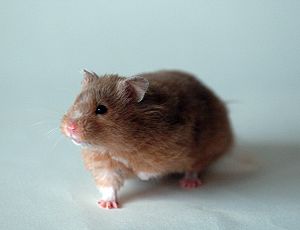Syrian hamster facts for kids
Quick facts for kids Syrian hamster |
|
|---|---|
 |
|
| A female pet hamster | |
| Conservation status | |
| Scientific classification | |
| Genus: |
Mesocricetus
|
| Species: |
auratus
|
| Synonyms | |
|
Cricetus auratus |
|
The Syrian hamster (Mesocricetus auratus), also called the golden hamster, is a popular type of hamster. These small animals naturally live in dry areas of northern Syria and southern Turkey. They got the name "golden hamster" because the very first ones kept as pets had a shiny gold color. Today, thanks to selective breeding, there are over 100 different colors and patterns!
Sadly, the number of wild golden hamsters is decreasing. This is because their homes are being destroyed by farming, and sometimes people even remove them on purpose. Because of this, the International Union for Conservation of Nature now considers wild golden hamsters to be an endangered species.
Syrian hamsters are kept as pets in many countries around the world. This includes the United States, Canada, most countries in Europe, and many more places.
Contents
Discovering Golden Hamsters
Golden hamsters originally come from Syria. Scientists first wrote about them in a book called The Natural History of Aleppo in 1797. Later, in 1839, a British zoologist named George Robert Waterhouse officially recognized the Syrian hamster as its own unique species. He named it Cricetus auratus, which means "golden hamster."
In 1931, some hamsters that had been raised in captivity were sent to Britain. They were cared for by the Wellcome Bureau of Scientific Research. These hamsters had babies, and two pairs were given to the Zoological Society of London in 1932. Their babies were then given to private pet breeders in 1937. Another group of hamsters was brought from Syria to the United States in 1971. However, studies show that all pet golden hamsters today are descended from just one female hamster. She was likely the one caught in Syria in 1930.
Hamster Body Parts
A Syrian hamster's body is similar to other rodents, especially other hamsters.
Skeleton and Bones
Hamster Teeth
Syrian hamsters have 16 teeth in total. They have 4 incisors (the front teeth) and 12 molars (the back teeth used for grinding). There's a gap between their incisors and molars called a diastema.
Spine and Tail
Like other animals, a hamster's spine is made of many small bones called vertebrae. A Syrian hamster has about 43 to 44 vertebrae. About 13 or 14 of these bones are in their short tail.
Legs and Feet
All hamsters have short legs. Because of this, their leg bones are small and can break easily. Hamsters that are overweight are more likely to have problems with their legs.
Hamster Senses
Syrian hamsters, like most animals, have five senses: sight, hearing, touch, taste, and smell.
They don't have very good eyesight. They mostly use their strong sense of smell to find food. Some people think they might be colorblind and don't see well during the day. This is because they are nocturnal (active at night) and can see blue-green colors but not red colors. However, other studies suggest they can see quite well. Their tongue senses taste in a similar way to humans: salty at the tip, bitter at the back, and sweet on the sides.
Hamster Reproduction
Not much is known about how Syrian hamsters reproduce in the wild. However, they have been very successful at having babies when kept in captivity, such as in labs, by breeders, and as pets.
Different Types of Golden Hamsters
Sometimes, long-haired hamsters are called "teddy bear" hamsters. They are just like short-haired Syrian hamsters, but their fur is much longer. You can find them in any color, pattern, or coat type that short-haired Syrians come in.
Male long-haired hamsters usually have longer fur than females. This often creates a "skirt" of longer fur around their back end. Long-haired females have shorter fur than males, but it's still much longer than a short-haired female's fur.
Images for kids
See also
 In Spanish: Hámster dorado para niños
In Spanish: Hámster dorado para niños







